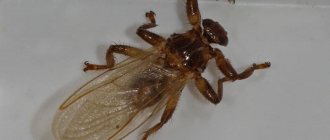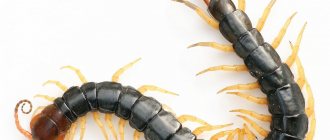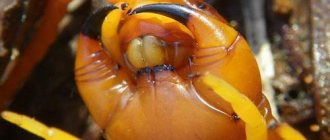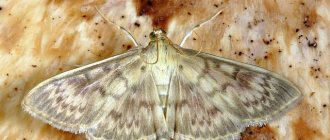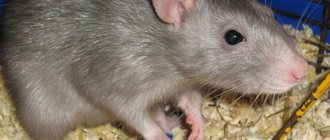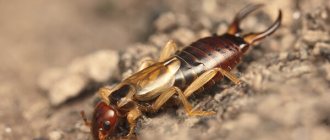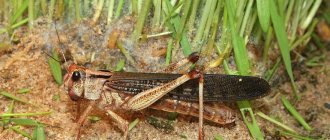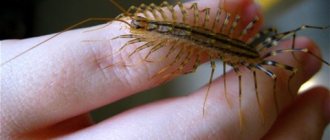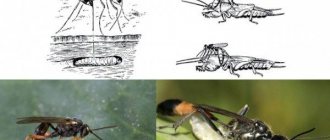In the fur of deer, elk, roe deer, as well as cattle, you can find a terrible parasite, which is popularly called the moose flea. The scientific name is moose bloodsucker, which has nothing in common with an ordinary flea or tick. This is a special type of blood-sucking insect, which, according to medical data, is not dangerous to the human body, since it is not on the list of carriers of serious diseases. A person can pick up the parasite in the forest in the summer-autumn period, especially in windless, warm weather. If you find an insect in your home, you must get rid of it immediately before it bites.
People's reaction to a moose tick bite
People's reactions to bloodsucker bites vary widely.
For some, this is a painless reaction, while others feel the bite quite strongly, accompanied by burning, redness and itching. The human body’s reaction to tick bites is also different. In one case, after a bite, a barely reddened spot appears, in place of which after a couple of days you can see a secondary skin reaction, accompanied by constant itching and lasting up to three weeks. In another case, the bite may not be noticeable, but after a few days a swelling may appear in its place, which will last on the body for about two weeks. According to studies of moose tick bites, scientists who observed the skin reaction were able to identify several types of dermatitis that characterize the bite of the bloodsucker. Bites were often accompanied by a rash, sometimes with crusting, itching and blisters in various variations, the effects of which took from 5 to 15 days to completely disappear. Some people had no reaction to a bite for many years, but after the next bite an acute inflammatory reaction appeared, which required long-term, months-long treatment.
Moose ticks do not transmit encephalitis or Lyme disease, although they occupy the same space and drink the blood of animals as the carriers.
Signs of plant damage by grass flea
Recognizing damage caused by psyllids is not difficult. The signs are largely similar to the appearance of aphids:
- sticky shoots, buds, leaves;
- delay in plant development;
- leaf curling;
- enveloping vegetative parts with white cobwebs;
- falling of leaves and buds;
- deformation and dropping of fruits;
- the appearance of black plaque (sooty fungus).
If at least one of these signs appears, the garden is infested with grass fleas.
What kind of insects are these?
In fact, there is no such species as moose louse in nature. All lice live exclusively on humans and feed on human blood; they simply do not perceive animals as food sources. And the insect in question belongs to the family of bloodsuckers and is a specific blood-sucking parasite of some warm-blooded creatures, that is, animals.
Moreover, they prefer mainly forest dwellers, such as deer, roe deer, deer, and so on. But sometimes they choose cattle as sources of food, as well as some other forest animals, for example, badgers, hares, foxes, and bears. Known names for this pest are: deer bloodsucker, moose louse (louse), moose fly, and also moose tick.
What do these parasites look like?
Moose lice are somewhat similar to some other parasites, so they are confused with fleas or bream. They have a flat body, the length of which reaches 2 - 5 millimeters (females are slightly larger than males). It has three pairs of tenacious legs covered with bristles. And at the tips there are some claws with which the parasite clings to the fur in order to remain on the animal’s body.
The head is flat, on the front part there are short antennae, which are usually hidden in special depressions (they are located on the frontal part). The eyes are large compared to other parts of the body; they are located on the sides of the head and can occupy a fourth of it. But in addition to these complex eyes, such an insect also has three simple, smaller ones. The mouthparts are of the piercing-sucking type and have a proboscis used for sucking blood.
It is noteworthy that the moose louse has wings, but does not use them very skillfully. So, usually it recognizes the smell and warmth of the animal and flies to it. Then she discards her wings, because they will no longer be needed. The parasite will remain on the body of the new host and will live on it for the rest of its life, regularly feeding and breeding.
If you manage to see a louse up close, it will look like a small brown fly if it has wings. The wingless bloodsucker vaguely resembles a tick, but still differs from it in its larger size, elongated body and long legs, which will certainly have scales and small claws.
Where are moose lice found?
Moose lice are common in many regions, for example, in China, North America, some Scandinavian countries, as well as many regions of Russia, such as Siberia, Primorsky Krai, and the entire European part.
Food facilities
Deer bloodsuckers hunt elk, deer, and red deer. They were found on wild boars, hares, birds, badgers and other inhabitants of the wild forest. Moose ticks also attack domestic animals. People are theoretically uninteresting to them, since after feeding on human blood the female “mite” is not able to give birth to offspring.
Interesting!
But deer flies have only instincts, so they are guided not by the type of mammal, but by its size. These “fleas” do not attack children under 8 years of age, preferring adults.
Parasitism on humans
Despite rare cases of transmission of infectious diseases by parasites and predictably developing symptoms after infection, the question of interaction with bloodsuckers remains open.
The elk tick is capable of attacking not alone, but with a “team”; the total swarm can be up to 120 individuals. The larger the prey appears to the insect, the more likely it is to land on it. For this reason, children on the street or at home will most likely not be affected by elk ticks.
As soon as the insect hits the skin, it waits 5-10 seconds (sometimes several minutes), after which it goes to the hair or under clothing. Whatever the type of skin a person has, the elk tick will leave consequences on the epidermis in any case. People with high sensitivity or thin skin feel the bite very painfully; people with a higher pain threshold may not even notice the first day. The pain is accompanied by a strong burning sensation, complemented by itching and instant redness. However, a full bite mark may only appear after a few days (Figure 4).
Figure 4. The bite of this parasite is extremely dangerous for humans
According to research, elk lice can leave four types of marks on humans:
- Fleeting - a mild rash with a crust, disappears in 4-5 days.
- Medium - the appearance of a tubercle with a crust, disappears in 10-12 days.
- Severe - the appearance of blisters and redness within a radius of 10-15 centimeters from the lesion, which resolve within 1 month.
- Extremely severe - development of hippoboscosis, dermatitis, erythema, the treatment of which will take up to six months.
Consequences of a bite for a person
A moose louse bite leads to the development of dermatitis.
Four types of dermatitis of varying severity have been identified:
- After the bite, a maculopapular rash appears, which disappears after 5-6 days without consequences.
- Rash of itchy papules that resolves within 2 weeks.
- Papular urticaria is the appearance of small blisters.
- There is no reaction from the body to the first bite of a bloodsucker. With subsequent bites, acute inflammatory exudative blisters develop, the treatment of which lasts up to six months.
With a repeated bite, an allergic reaction, local or systemic, may develop, since insect allergens persist for a long time in the human blood.
When bitten by a deer bloodsucker, a person experiences:
- itching, hyperemia after 5-10 minutes;
- rash formation after 5-12 hours;
- at the site of the rash, after 20-25 hours, vesicles with serous contents form;
- transformation of vesicles into pustules, from which yellow liquid oozes for 5-15 days;
- As the liquid is released and dries, brown crusts form.
After the crusts are rejected, dark spots remain on the skin that do not resolve for more than 1 month.
It is easy to treat parasite bites at home. The surface of the skin is treated with hydrogen peroxide. An antipruritic agent, which includes menthol, camphor, and kelamine, is applied to the bite sites.
Papules should not be scratched. In this case, a secondary infection may occur. Your doctor will tell you which antibiotics to take at your clinic appointment.
The consequences of numerous bites can be mistaken for lice or another skin disease.
The body's reaction to bloodsucker bites is individual. It is believed that people who constantly go into the forest and are often attacked by lice react to bites more and more sharply over time.
It has been found that bloodsuckers are most active when the weather is humid.
When attacking, moose flies are guided by the size and color of the victim. Having good eyesight, they notice moving figures of people or animals. The one walking in front is attacked by a larger number of bloodsuckers. If there is a child in the group, the lice may not notice him.
They prefer dark gray and dark brown clothing colors. They will ignore a jacket made of synthetic slippery fabric. Clothing made of natural, loose materials that you can cling to with your claws attracts them to a greater extent.
Hunters have noticed that moose lice prefer the scalp, especially the back of the head. They immediately shed their wings and begin to feed, piercing the skin with a strong proboscis. A moose fly that has shed its wings and has a flat body becomes like a tick.
Despite the fact that the causative agents of Lyme disease were found in a quarter of the bloodsuckers studied, medical statistics do not confirm the fact that they carry infectious diseases. This is facilitated by the bloodsucker’s lifestyle. It parasitizes all its life on one host, unlike ticks, which use several victims for feeding, including natural reservoirs of infectious diseases - rodents.
Popular questions
Fearing becoming a victim of blood-sucking insects, people often ask the following questions:
- How to protect yourself from parasite bites in the forest? To avoid becoming a source of food for moose fleas, it is necessary to take protective measures: wear a mosquito net, thick clothing that blocks access to the body, use high-quality repellents, and inspect yourself for the presence of insects.
- What means and methods of protecting animals and humans exist? If you find a attached fly, you need to drop some vegetable oil on it, then carefully unscrew it clockwise using tweezers. After this, disinfect the bite site with iodine, hydrogen peroxide, and take antihistamines (Diazolin, Suprastin, Psilo-balm, Fenistil-gel, Bepanten).
- How to identify a moose flea bite? Depending on the degree of sensitivity of the skin to the bloodsucker’s saliva, redness with an itchy papule appears at the site of the bite; after about a week, the affected area of the skin becomes covered with erythrema, the treatment of which takes six months.
There are a huge number of insects in the world, among which there are species that are dangerous to humans and animals, characterized by parasitic characteristics, including the way they feed. You can meet a blood-sucking insect that can suddenly attack not only in the forest, on the street, but also in your own home.
To prevent serious consequences of a bite, it is recommended to follow safety precautions.
Types of parasites
There are a huge number of these insects, and many believe that they are all representatives of different species. In fact, there are not that many families. They are often given names depending on where they live. Let's look at the most popular types of bloodsuckers.
- Home or bed. There is no such separate species. This is what people call the varieties of fleas in the house that feed on the blood of people, dogs and cats. They live in animal fur, on pet bedding, in carpets, upholstered furniture, on bedding, under baseboards, jumping from an infected animal to a person.
- Human. Household fleas live in residential areas. They parasitize people, but in the absence of the main host they do not disdain domestic animals. Preference is given to pigs, since the skin of these mammals, like that of humans, does not have wool or coarse hair. This greatly simplifies the feeding process. Flea bites are painful, cause redness, swelling, allergic reactions, and can transmit diseases dangerous to humans.
- Feline. They live mainly in the fur of cats, but are able to feed on the blood of other animals. If a cat has fleas, the animals behave restlessly: they itch, get nervous, trying to free themselves from uninvited guests.
- Canine. The flea looks like all other species. It lives in the fur of dogs and is the most survivable insect, as it can go for a long time without food. In the absence of the owner, it attacks other animals and humans. Sometimes so-called white fleas may appear on a dog. According to the description, they are similar to these parasites, but they are a different pest. It's called a lice eater. Its bites are also painful and cause severe itching.
- Earthen ones. They inhabit basements and upper layers of soil. They love damp places, but can also appear in apartments. Usually, residents of the first floors are surprised to find these guests on their territory. Fleas are used as hosts for wild animals, cats, dogs, and rats. It is difficult to notice parasites because they hide in the ground.
- Chicken. Insects that live on poultry and hazel grouse do not need to move around in the feathers for a long time to find a favorable place to bite. They prefer to feed on blood near the eyes and beaks. The most delicate skin is there. But parasites often attack other warm-blooded animals, budgies.
- Rat. These flat fleas also inhabit basements, where they find their main hosts, rats. But they can parasitize dogs, cats and people. They are divided into two groups: European and southern. The latter species is the most dangerous, as it can carry serious diseases, including bubonic plague.
- Sandy. The inhabitants of the sands have a lighter color, since the shell fades after being exposed to sunlight for a long time. These fleas are native to Thailand and Vietnam. Numerous tourists do not allow insects to die of hunger. Bloodsuckers bite people on the legs, arms, and buttocks, since it is impossible to notice the insect in the sand. The bites are painful, cause itching and suppuration if the wound gets infected.
Type of flea
Interesting facts about fleas are very educational. The tiny insect can pull 160,000 times its own weight. For a person, this would equal 2,689 double-decker buses. A flea is able to jump non-stop 30,000 times to a height that is 150 times its own height.
Types of fleas and their control are often discussed on forums. If the premises are heavily infested with parasites, then it is best to contact special services that will professionally disinfest all surfaces, clothing and furniture using effective modern means. But first you need to determine the types of fleas in the apartment in order to use the most effective insecticide and get rid of fleas in the apartment.
To combat parasites in animals, various shampoos, drops on the withers, collars, and tablets are used. Powders. There is no point in delaying flea removal activities, since 25 females per month can produce offspring of a quarter of a million.
Damage caused
First of all, when it comes to gardens, fruit trees and shrubs . If you notice that the leaves of your plantings have begun to shrink and curl into tubes , and a sweetish web is visible on the surface , then grass fleas have become your neighbors. And they have plans for a harvest that they will have to defend firmly and stubbornly.
In the home, grass fleas can also cause discomfort to humans. In addition to their direct presence, they often cause multiple bites .
A grass flea bite is often characterized by severe redness around it , this is due to the fact that the substance released by the flea into the blood is a strong allergen (how to treat the symptoms of a flea bite?).
IMPORTANT ! Like any blood-sucking insect, the grass flea can become a carrier of infection. For this reason, in addition to the first aid that must be provided for such bites, it is worth immediately starting to expel uninvited guests from the house.
Prevention measures and methods of disposal
The smell of sweat and warmth are especially attractive to moose lice. Therefore, for a trip to the forest you need to choose the appropriate clothes. The most reliable option is a special protective suit that reliably hides all parts of the body. It is desirable that it be made of thick fabric, have cuffs on the legs and sleeves, as well as a collar that fits well to the neck.
We suggest you read: Why do rats appear in the house?
To protect the most exposed part of the body - the head - you can use a mosquito net. It is indispensable during forest walks in the summer. You can also protect yourself from moose fleas using specialized products, such as repellents.
Many users note that not all of them are effective. Therefore, when purchasing them, you should opt for a powerful drug that has a noticeable odor and a high saturation of active ingredients.
Experts recommend using Deta or Taiga sprays. All clothes need to be treated with them so that bloodsuckers can smell the smell from a great distance and do not even try to consider a person as their potential victim.
To avoid attacks by ticks, fleas, bedbugs and other parasites, it is recommended to take preventive measures before going into open space (forest, field). Among them:
- Wear closed clothing made of thick fabric or protect yourself with mosquito nets, mesh hats, sleeves and other items of specialized clothing;
- Treat skin and clothing with repellents against ticks and lice;
- Carry out a thorough body check after returning home.
In the event that it was not possible to avoid the attack of the bloodsucker, the following actions must be taken:
- Remove and shake off clothes well;
- Wash clothes in hot water, steam with an iron and dry, then shake off again to remove surviving parasites;
- Take a shower or bath, wash your hair thoroughly and comb it;
- If necessary, use specialized insecticidal preparations (sprays, solutions or emulsions) designed to combat ticks, fleas and other parasites.
In order to remove deer bloodsucker from the skin, you can also use the following methods:
- Take the flea by the abdomen using tweezers or thin tweezers and carefully remove it from the wound;
- Applying vegetable oil to the body of the bloodsucker, as a result of which it stops receiving oxygen and begins to break out on its own;
- Pass a regular nylon thread under the abdomen of the parasite and tighten the loop, then remove it by swinging it in different directions, and treat the bite site with a disinfectant.
Using these steps, you can get rid of moose fleas yourself. If the above measures do not help, and the bites cause complications, it is necessary to prescribe special medications by a doctor.
What danger do grass fleas pose?
Grass flea beetles (wood flea beetles) pose a serious threat to fruit trees and vegetable crops. With the end of winter, these pests begin an active period of life. Insects damage young blossoming leaves of fruit crops, drink plant juice, and interfere with the development of stems and young shoots.
The greatest danger is represented by the larvae of grass fleas - nymphs. Nymphs are very voracious and inactive. The digestive system of nymphs is not able to absorb all the substances entering the body. During active feeding, the waste products of the larvae are a sticky sugary liquid covering the surface of the leaves and stems. This liquid attracts aphids, which further damage the plant. The sweet coating, called “honeydew,” serves as a breeding ground for sooty fungus. These parasitic microorganisms cover the tips of young shoots and unopened buds with a black coating. As a result of such a strong impact, the plant dries out greatly and stops bearing fruit.
Grass fleas
If grass fleas appear in the house and feed on seedlings on the windowsill or flowers in pots, then these plants can become infected with fungal spores, especially in conditions of high humidity and elevated temperatures.
Most often, apple trees, sweet varieties of pears, plums, strawberries, carrots and cereals suffer from grass fleas. Among indoor plants, the most vulnerable are those species that have soft, succulent stems and young blooming buds.
Warm-blooded animals and humans are not victims of these parasites, so any pet is not in danger. The parasite's mouthparts are not adapted to pierce the skin of mammals and are not capable of biting.
Description and characteristics of moose lice
Like all parasitic insects, the deer bloodsucker first flies up or jumps up to the victim, then tightly attaches itself to the hairs and breaks off its wings, changing its lifestyle to a sedentary one (Figure 1).
Among its victims may be deer, elk, horses, cows and even bears.
A moose fly, entangled in the long fur of an animal, is similar to a tick. After shedding its wings, you will see its translucent oval red-brown body and tenacious legs, like a tick. The elk fly measures approximately 3 mm in length. With wings this mark reaches 6 mm.
Figure 1. These blood-sucking insects prefer to live in bushes and tall grass
Walking through the summer steppe or warm forest glades, you can see what an elk tick looks like - it’s practically a flat-bodied fly that will persistently try to land on your skin.
Precautionary measures
If you still don’t want to be bitten by a moose fly, how to protect yourself? First, know the enemy's habitat. It is better to refrain from picnics in the meadows in late summer or early autumn. Because deer ticks prefer to bide their time in tall grass or brush in open areas, avoid camping or photographing in these areas.
Secondly, keep in mind that parasites are also transmitted through contact with cows, horses, and sheep. Also, to protect livestock from the invasion of deer ticks, treat the animal’s fur with a special solution. Hunters should also take note: while cutting up a carcass, insects actively jump onto all exposed areas of the skin.
It is possible and even necessary to fight moose flies with the help of insecticides, for example, for livestock, these are products like “Cyphlon”.
Preventive actions
In order to avoid becoming a victim of insects, you need to follow several recommendations:
- There is no need to go to the forest in August-September; these are the months when the deer bloodsucker is most active.
- Clothes for visiting the forest should be thick and have long sleeves and legs. Hair and face must be covered with a scarf.
- To be on the safe side, you can treat your clothing and skin with insect repellent.
- Since hunters are most exposed to attacks when cutting up an animal carcass, they need to use a mosquito net and gloves when doing this.
- After visiting the forest, you should carefully examine the clothes you were wearing, and most importantly, your body. After all, during a walk you might simply not feel the insect bite, and it continues to sit on your skin.
Follow these rules, and walks in the forest will bring you only joy and positive emotions!
Reviews
Dear readers, was this article helpful? What do you think about the moose flea (moose bloodsucker). Leave feedback in the comments! Your opinion is important to us!
Anton
“Last summer there was an invasion of bloodsuckers in our region. It was impossible to be in the forest, near the swamp. They attack worse than midges. The bite hurts, and the itching is just terrible! Repellents do not help, clothing protects, but even then not always. The neck suffers the most. From my observations, I noticed that they attack more if a person is sweating, actively moving, and if you walk calmly through the forest, trouble can be avoided.”
Stas
“In our area, only a good mosquito suit helps, there is no need to come up with anything else. Shepherds and hunters always wear this equipment. No other way!"
Remedies for protecting moose lice in the forest
An elk louse can only get on a person by accident. Human blood is not suitable for the bloodsucker; by feeding on it, the parasite stops producing offspring.
When going to the forest in the warm season, you need to choose clothes that will hide your body as much as possible, because an insect can get under your clothes or onto your hair. The use of special means – repellents – will help protect against insects. They need to treat all clothing and open areas of the body. Parasites must smell an unpleasant odor. Therefore, repellents should be chosen with a strong, persistent odor and a high content of active ingredients. Any mosquito repellent will be suitable for these purposes. For lasting results, treatment is carried out every 3-4 hours.
When you come home from the forest, you should carefully examine your clothes and body for the presence of insects. Afterwards, comb your hair with a fine-toothed comb.
There is no need to worry that an elk louse accidentally brought into the house will take root, since the parasite will not be able to exist in a living room.
There may be cases of detection of bloodsuckers in dacha and garden plots located near forest belts. For protection, trees and bushes should be thoroughly treated with insecticides, and tall grass should be mowed if possible. An effective remedy in the fight against moose lice is to plant plants on a plot of land that can repel them. Such plants include common wormwood and tansy. The bloodsucker does not tolerate moisture, so you should spray the lawn and trees more often. Some gardeners recommend adding alcohol or garlic juice to the water.
Clothing requirements
- Clothing should be loose but cover all areas of the body. The optimal model is overalls.
- Sleeves of jackets and sweaters - with cuffs that fit the wrists or are fastened with an elastic band.
- Button the shirt at the collar with all the buttons
- The trouser legs, preferably also with cuffs or tucked into shoes, should be secured with socks.
- Moose ticks can be detected faster on plain overalls.
- The head and face are protected with a mosquito net. If it is absent, tie a scarf tightly or wear a hat.
- A windbreaker or jacket with a hood is best.
If a tick has attached itself
To remove an elk tick, carefully twist it counterclockwise.
- Before going into the forest, you should be on the safe side and “attack” elk ticks yourself: use strong repellents containing DET. They will repel insects.
- If ticks end up on your body, getting under your clothes, you need to get rid of them. This can be done in several ways:
- Apply cream to the site of the fly bite or drip sunflower oil onto the parasite. As a result of blocking the air supply, it will disappear on its own in 10-15 minutes.
- Remove the insect with tweezers, twisting its body counterclockwise, making sure that the proboscis is also removed.
- If you have a thin thread at hand, then pry the belly of the fly from below, make a loop, tighten it on the body and gradually swing it, remove the bream.
- Treat the bite site. After disinfection, you need to see a doctor.
How to fight in an apartment
Since the insect's wings are poorly developed, they rarely fly, lying in wait for their prey in the grass. They are attracted to large animals with a slow lifestyle, so moose are most often attacked.
However, there are situations when the parasite attacks a person and is found in an apartment.
Some people react neutrally to an insect bite, others experience it very painfully, but the consequences for all are very serious and require long-term treatment. If an elk flea is found in an apartment, it is necessary to get rid of it as soon as possible, and also apply preventive measures.
Video
Making a flea trap with your own hands
Usually, a fly can appear at home after the owners visit the forest while picking mushrooms, berries, and herbs. Since the parasite can attack other ungulates, except moose, it can be brought into an apartment after interacting with livestock grazing in areas where the species is distributed.
Another option for a bloodsucker to enter a home is for birds to carry it onto balconies and window sills of houses.
To reduce the risk of bringing flies into your apartment, you should take safety precautions before going for a walk in the forest. Clothing should cover exposed areas of the body as much as possible; it is advisable to have thick elastic bands on the cuffs of sleeves and pants. For effective protection against fleas, ticks, and other blood-sucking insects, it is recommended to use a Biostop protective suit.
If you find an insect in your apartment, it is recommended to use pest control products.
The following tools are great for this:
- Dichlorvos;
- Raptor;
- Varan;
- Destructive force.
During the treatment of the premises, it is necessary to strictly adhere to the protective measures set out in the instructions for the drug used.
There are also folk remedies in the form of herbs, placed around the apartment, which repel blood-sucking parasites with their smell. These include wormwood, tansy, celandine, chamomile, and lavender.
Parasite behavior
Appearance of a flea
Not everyone knows what fleas look like. People who do not have animals in their homes usually have very general ideas about these insects. A person may not know whether fleas have wings. He, unlike a zoologist, is not interested in the question of the number of legs a flea has. But this does not mean that he will never encounter this phenomenon in his life. Parasites can be accidentally brought home from stray dogs and cats from the street. Infection is possible while relaxing in the forest or on the beach.
Fleas are found in all seasons of the year. Both males and females feed on blood. They live in the nests of birds, squirrels, in the burrows of gophers, hamsters, jerboas and other small animals, and are distributed throughout the world. The main hosts are mammals. Representatives of fleas have been found even in Antarctica. But against the general background, the colony of insects that bite humans is not so numerous.
The feeding process can last from one minute, if the parasite is disturbed, to several hours. Some species require multiple meals, others are rarely saturated, but in excess, without even having time to digest the incoming blood. There are insects that leave the owner after their meal, but there are also those that remain in the animal’s fur until the next attack of hunger.
On the Internet you can find any information about what kind of fleas there are, where they live, and the characteristics of this type of blood-sucking insect. In real life, they are difficult to see without special devices, so you can see the fleas in the photo in a greatly enlarged form.
Fleas
Varieties of grass fleas
About 100 species are widespread in Russia. Some of them cause damage to agricultural crops, for example:
- Stem cereals (genus Chaetocnema aridula and Chaetocnema hortensis) – affecting winter and spring crops even at the stage of germination and formation of stems, many species of this genus are also dangerous for sugar beets;
- striped flea beetle (Phillotreta vittula) - a thunderstorm of cruciferous plants;
- blue and black flax flea beetles are capable of destroying flax crops in a matter of days and repeatedly during the season;
- hemp flea beetle (Psylliodes attenuate Koh) - causes harm not only to mulberries, but also to hops.
Gardeners are well aware of the grass fleas that attack fruit, berry and vegetable plantings:
- common and large pear honeydew (Psylla pyricola);
- apple honey beetle (P. mali);
- carrot psyllid (Trioza viridula) – the intermediate host is coniferous trees (overwinters);
- Libya (Livia juncorum) – leaves galls on flower crops, sedges.
In some varieties, only the larvae cause significant harm, and basically all stages of the formation of an individual are dangerous for the development of the plant.
Is it dangerous for humans?
When wondering whether moose fleas are dangerous for humans, it should immediately be noted that the main danger is the incredible gluttony of the bloodsucker.
Considering the daily blood consumption required for them, the massiveness of the attacks, one can say that a large loss of blood can lead to death.
Once on human skin, the flea remains motionless for some time, after which it begins to eat.
If you notice an individual in time and shake it off before the bite, you can maintain a healthy state. If a bite occurs, after 20 minutes redness, swelling, and severe itching will form at the site of the injury. It is possible that the skin may develop blisters with liquid inside.
Correct treatment
It is worth understanding that if any symptoms appear on the skin, this indicates that the body is signaling a problem. If this manifestation resembles a mosquito bite, then, of course, no one will run to the doctor with such a problem, and most often this is what happens. But action must be taken, since complications are quite possible, which are much more difficult to cope with.
If we talk about folk methods, which, by the way, are quite effective in this case, then there are quite a lot of them. For example, to get rid of unbearable itching, you can use regular soda; for this, it is mixed with a small amount of water to form a paste and applied to the affected area.
Ice will also improve the condition; wrap it in a towel and apply it to the wound. It will help relieve swelling, reduce inflammation and itching. Ideal helpers are calendula tincture and aloe juice, which relieve symptoms and have a beneficial effect on the condition of the skin. Zvezdochka balm is often used and is also effective.
In relatively severe situations, when the manifestations are pronounced, the use of ointments and medications is required. This treatment should only be prescribed by a doctor after examination. It is forbidden to choose medications on your own or on the recommendations of friends, as this can only cause harm and aggravate the condition.
Actions after disinfestation
You should enter a cleaned and treated apartment after it has been thoroughly ventilated. Carry out wet cleaning of places that have to be touched, except for the floor. When sprayed, the chemical may accidentally get on door handles, armrests, or table surfaces. Treatment with a soap-soda solution neutralizes the effects of the insecticide.
Types of fleas.
The bed is covered with clean linens, armchairs and sofas are covered with washed bedspreads. Then the lid is removed from the aquarium, the artificial air compressor is turned on, and children and pets are brought in. It is not recommended to wash the floor for 2 weeks after treatment. Upholstered furniture and floor coverings should be vacuumed every day to remove dead insects.



